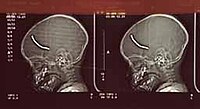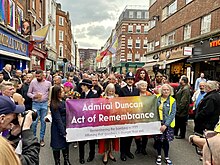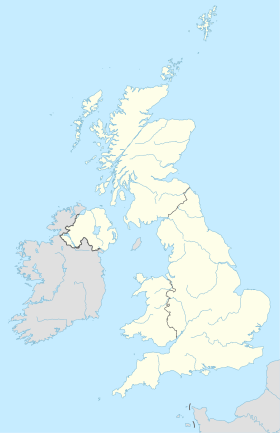1999 London nail bombings
| 1999 London bombings | |
|---|---|
| Location | London,England |
| Date | 17 April 1999– 30 April 1999 |
| Target | Black British,British BengaliandLGBTpopulations in London |
Attack type | White supremacistterrorism,bombings,murder |
| Weapons | Nail bomb |
| Deaths | 4 (including an unborn baby) |
| Injured | 140 |
| Victims |
|
| Motive | Neo-Nazism / Attempt to start arace warin England |
| Part ofa serieson |
| Terrorism |
|---|
| Part ofa serieson |
| Neo-fascism |
|---|
 |
|
|
The1999 London nail bombingswere a series of bombexplosionsinLondon,England. Over three successive weekends between 17 and 30 April 1999, homemadenail bombsweredetonatedinBrixtoninSouth London;atBrick Lane,Spitalfields,in theEast End;and at theAdmiral Duncanpub inSohoin theWest End.Each bomb contained up to 1,500 100 mm nails, induffel bagsthat were left in public spaces. The bombs killed three people and injured 140 people, four of whom lost limbs.
On 2 May 1999, theMetropolitan Police Anti-Terrorist Branchcharged 22-year-old David Copeland with murder. Copeland, who became known as the "London nail bomber", was aNeo-Nazimilitant and a former member of two political groups, theBritish National Partyand then theNational Socialist Movement.The bombings were aimed at London'sblack,Bengali,andLGBTcommunities.[1]Copeland was convicted of murder in 2000 and given sixlife sentences.[1]
Overview
[edit]Brixton Market bomb
[edit]
The first bombing, on Saturday, 17 April 1999, was inElectric Avenue,Brixton,an area of south London with a large black population. The bomb was made using explosives from fireworks, taped inside a sports bag, primed and left atBrixton Market.The Brixton Market traders became suspicious, and one of them, Gary Shilling, moved the bag to a less crowded area after seeing perpetrator Copeland acting suspiciously. Two further moves of the bomb occurred by unconvinced traders, including the bomb being removed from the bag, which is when it ended up next to theIceland supermarket.Concerned traders called the police, who arrived at the scene just as the bomb detonated at 5:25 pm. Forty-eight people were injured, many of them seriously because of the 4-inch (100 mm) nails that were packed around the bomb. The explosion was strong, sending nails in all directions, blowing windows and blasting a parked car across the street.[2]
Brick Lane bomb
[edit]The second bomb, on the following Saturday, 24 April, was aimed atBrick Lanein theEast End of London,which has a largeBangladeshicommunity. There is a street market on Sundays, but perpetrator Copeland mistakenly tried to plant the bomb on Saturday when the street was less busy. Unwilling to change the timer on the bomb, he instead left it in a blackReebokbag onHanbury Street.There it was picked up by a man who brought it to the police station on Brick Lane, which was shut. The man had placed it in the boot of hisFord Sierracar which was parked outside number 42 Brick Lane, where it exploded.[3]Thirteen people were injured, and surrounding buildings and cars were severely damaged.[4]
Admiral Duncan bomb
[edit]The third and final bomb was planted and detonated on the evening of Friday, 30 April atThe Admiral Duncanpub onOld Compton StreetinSoho,the heart of London'sgay community.At the time the pub and the street outside were crowded because the evening was the start of abank holidayweekend. The unattended sports bag containing the bomb, which was taped inside, was noticed by patrons of the Admiral Duncan; however, the bomb exploded at 6:37 pm just as the bag was being investigated by the pub manager, Mark Taylor.[5]Three people were killed and a total of seventy-nine were injured, many of them seriously. Four of the survivors had to have limbsamputated.[6]

Victims
[edit]
| Casualties (deaths) | |
|---|---|
| Brixton | 48 (0) |
| Brick Lane | 13 (0) |
| Soho | 79 (3) |
At the pub bombing in Soho, Andrea Dykes, 27, four months pregnant with her first child, died along with her friends and hosts for the evening, Nik Moore, 31, and John Light, 32, who was to be the baby'sgodfather.Andrea's husband, Julian, whom she married in August 1997, was seriously injured. The four friends fromEssexhad met up in the Admiral Duncan to celebrate Andrea's pregnancy.[7]
Investigation and arrest
[edit]Following the Brixton bombing, officials initially emphasised thatIRAinvolvement was unlikely and that it was more likely to be the work of right-wing terrorists following theStephen LawrenceInquiry that was released at the time, or a 'copycat' ofEdgar Pearce.On 19 April,Combat 18,aneo-Naziterrorist[8]organisation, claimed responsibility via telephone.[9]By the time of the Brick Lane bombing a week later, which the police linked with the Brixton bombing, it was clear that a racist entity was behind the attacks. It also ignited fears of racial tensions, particularly after the release of the Stephen Lawrence Inquiry in February, and as Brixton was the scene ofrace riots in 1981.[10]
Although these had been described by the police as specifically race-hate attacks, they had issued a warning that agay barcould potentially be the bomber's next target, and The Yard – a pub in the Soho area – had displayed a poster warning customers to be alert.[5]On Thursday, 29 April, CCTV footage from the Brixton attack was given wide publicity after an image of the suspected bomber was identified on it. This caused Copeland to bring forward his planned bombing of the Admiral Duncan to Friday evening. Paul Mifsud, a colleague of Copeland, recognised him from the footage and alerted the police about an hour and twenty minutes before the third bombing.[11]
The Admiral Duncan bombing was linked to the previous ones by police, with far-rightists once again theprime suspects.Two hours after the bomb, theneo-NaziWhite Wolvesorganisation[12]claimed responsibility for the attack. It was feared other ethnic minorities, such asJewsandAsians,would be targeted next. Somesynagoguesincreased security as a result.[13]
Copeland was arrested that night once the police obtained his address, a rented room in Sunnybank Road,Cove,Hampshire.He admitted carrying out the three bombings as soon as he opened the door to the police, telling them, "Yeah, they were all down to me. I did them on my own." He showed them his room, where twoNaziflags were hanging on a wall, along with a collection of photographs and newspaper stories about bombings.[14]
In May 2021 the informant 'Arthur' who identified Copeland spoke toThe Guardianabout David Copeland and the contemporary threat from the extreme right.[15]
Perpetrator
[edit]
David James Copelandwas born on 15 May 1976, inHanworthin theLondon Borough of Hounslow,[16]to a working-class couple. His father was anengine driver[17]and his mother was a housewife. Copeland lived for most of his childhood with his parents and two brothers inYateleyin Hampshire, attendingYateley School,where he obtained sevenGCSEsbefore leaving in 1992. Journalist Nick Ryan wrote that, as a teenager, Copeland feared he washomosexual;when his parents sang along toThe Flintstonesthemeon television— "we'll have a gay old time" —he reportedly believed they were sending him a message. As an older teenager, he began listening toheavy metalbands and earned himself the nickname "Mr Angry". Ryan wrote that the staff at his school have no recollection of him during this period, as if he had become invisible.[17]
After his arrest following the bombings, Copeland told psychiatrists that he had started havingsadomasochisticdreams when he was about twelve years old, including dreams or fantasies that he had been reincarnated as anSSofficer with access to women as slaves.[18]He left school for a series of failed jobs, reportedly blaming immigrants for the difficult job market. Copeland became involved in petty crime, drinking and drug abuse. His father was eventually able to get him a job as an engineer's assistant on theLondon Underground.[17]
Copeland's father called him "fairly intelligent" as a child. His parentsseparatedwhen he was aged 19, and his mother told lawyers and psychiatrists after the arrest that he was a "happy lad" and showed no sign of what was to come. According to psychiatrists, Copeland also had a higher than averageIQ.[19]One of the doctors believed his behaviour started to change around 1995 when he was 19, isolating himself from friends and family.[20]
Political views
[edit]Copeland joined the far-rightBritish National Party(BNP) in May 1997, at the age of 21. He acted as a steward at a BNP meeting, in the course of which he came into contact with the party's senior members and was photographed standing next toJohn Tyndall,the leader of the party at the time. During this period Copeland readThe Turner Diaries,and first learnt how to make bombs using fireworks with alarm clocks as timers after downloading theAnarchist Cookbookfrom the Internet. Copeland left the BNP in 1998, regarding it as insufficiently hardline because it was not willing to engage inparamilitaryaction,[21]and joined the smallerNational Socialist Movement,becoming its regional leader for Hampshire just weeks before the start of his bombing campaign. It was around this time that he visited his family doctor and was prescribedanti-depressantsafter telling the doctor he felt he was losing his mind.[14]
Motivation
[edit]Copeland maintained he had worked alone and had not discussed his plans with anyone. During police interviews, he admitted holdingneo-Naziviews and talked of his desire to spread fear and trigger arace war.He told police, "My main intent was to spread fear, resentment and hatred throughout this country; it was to cause a racial war." He said, "If you've readThe Turner Diaries,you know the year 2000 there'll be the uprising and all that, racial violence on the streets. My aim was political. It was to cause a racial war in this country. There'd be a backlash from the ethnic minorities, then all the white people will go out and vote BNP. "[22]
After his arrest, Copeland wrote to BBC correspondent Graeme McLagan, denying that he hadschizophrenia,and telling McLagan that the "Zog" orZionist Occupation Governmentwas pumping him full of drugs in order to sweep him under the carpet. He wrote, "I bomb the blacks, Pakis, degenerates. I would have bombed the Jews as well if I'd got a chance." Ryan writes that Copeland's first idea had been to bomb theNotting Hill Carnivalafter seeing images of the 1996Atlanta Olympics bombing.[17]When asked by police why he had targeted ethnic minorities, he replied, "Because I don't like them, I want them out of this country, I believe in the master race."[23]Whilst onremand,Copeland also wrote to crime writerBernard O'Mahoney,who posed as a woman called Patsy Scanlon in the hope of duping Copeland into confessing. According toThe Independent,the letters helped secure a conviction by giving prosecutors evidence about Copeland's state of mind.[24]In one letter to "Scanlon", Copeland wrote about how he was faking mental illness and was amazed by how many experts accepted his lies; the letter was included in the trial and greatly damaged the hopes of his defence team, in getting a manslaughter conviction based on extenuating circumstances.
Conviction
[edit]Copeland's mental state was assessed atBroadmoor Hospital.He was diagnosed by five psychiatrists as havingparanoid schizophrenia,while one diagnosed apersonality disordernot serious enough to avoid a charge of murder. There was no dispute that he was mentally ill, but the extent of this, and whether he was unable to take responsibility for his actions, became a matter of contention. At theOld Bailey,Copeland's plea of guilty tomanslaughteron the grounds ofdiminished responsibilitywas not accepted by the prosecution or jury.[14]
On 30 June 2000, Copeland was convicted of three counts of murder and planting bombs and given sixlife sentences.[1]The trial judge doubted that it would ever be safe to release Copeland.[25]
On 2 March 2007, theHigh Courtdecided that Copeland should remain in prison for at least fifty years, ruling out his release until 2049 at the earliest, when he would be 73.[21]Copeland appealed; on 28 June 2011, theCourt of Appealupheld the ruling.[26]
Further conviction
[edit]In June 2014, Copeland attacked a fellow inmate atHM Prison Belmarshwith ashiv,an improvised weapon made from razor blades attached to a toothbrush handle. In October 2015, he pleaded guilty towounding with intentand was sentenced to a further three years in prison, of which he will serve eighteen months.[27]
Media
[edit]The events of the 1999 bombings were the topic of several media investigations. In 2000, Nick Lowles wroteMr. Evil: The Secret Life of Pub Bomber and Killer David Copeland(John Blake, 2000;ISBN9781857824162).
In early 2021Netflixreleased the documentaryNail Bomber: Manhunt.
See also
[edit]- Right-wing terrorism
- Combat 18
- Tony Lecomber
- David Myatt
- The First Domino,a 2009 play written by one victim of the Soho bomb[28]
- Homophobia
- White supremacy
- Xenophobia
References
[edit]- ^abcBuncombe, Andrew; Judd, Terri; and Bennett, Jason."'Hate-filled' nailbomber is jailed for life",The Independent,30 June 2000.
- ^Thompson, Tony; Honigsbaum, Mark; and Ridley, Yvonne."Nail bomb injures 48 in Brixton blast"Archived14 April 2020 at theWayback Machine,The Guardian,18 April 1999.
- Carroll, Rory and Woodward, Will."Bomb survivors tell of bloody chaos"Archived1 September 2020 at theWayback Machine,The Guardian,19 April 1999.
- For the image of the baby, see"The London nail bombs"Archived15 June 2016 at theWayback Machine,The Guardian,accessed 2 March 2011.
- ^Sengupta, Kim; Gregoriadis, Linus; Mullins, Andrew (26 April 1999)."East London Bombing: 'We knew Brick Lane would be next, but thought it wouldn't be so quick'".The Independent.Archived fromthe originalon 1 May 2022.Retrieved3 December2014.
- ^"Car bomb explodes in London's Brick Lane"Archived4 June 2016 at theWayback Machine,Press Association, 24 April 1999.
- Millar, Stuart.'We're at war and if that means more bombs, so be it...'Archived4 June 2016 at theWayback Machine,The Guardian,27 April 1999.
- Millar, Stuart."Anti-terror police seek White Wolf racist over bombs"Archived4 June 2016 at theWayback Machine,The Guardian,28 April 1999.
- ^abSimon Edge."Look Back in Anger".Gay Times.Archived fromthe originalon 28 September 2011.Retrieved30 July2011.
- ^"Nail bomb explosion at London pub kills two"Archived4 June 2016 at theWayback Machine,The Guardian,30 April 1999.
- By Honigsbaum, Mark; Campbell, Denis; Thompson, Tony; Ryle, Sarah; Veash, Nicole; and Wazir, Burhan."Bomb factory man seized as death toll rises"Archived4 June 2016 at theWayback Machine,The Guardian,2 May 1999.
- "Gay community hit by nail bomb"Archived4 June 2016 at theWayback Machine,The Guardian,5 May 1999.
- Vasagar, Jeevan."Celebration that ended in deaths of three friends",The Guardian,1 July 2000.
- ^Jeevan VasagarCelebration that ended in deaths of three friendsArchived20 May 2018 at theWayback Machine1 July 2000theguardian,Retrieved 17 April 2019
- ^"Canada adds neo-Nazi groups Blood & Honour, Combat 18 to list of terror organizations".Global News.26 June 2019.Archivedfrom the original on 26 June 2019.Retrieved2 April2022.
- ^Combat 18 'claims nail bomb attack'Archived24 December 2007 at theWayback Machine,19 April 1999,news.bbc.co.uk,Retrieved 17 April 2019
- ^Andrew Mullins and Mark RoweThe Brick Lane Bomb: Race terrorism fear as bomb blasts East EndArchived6 April 2019 at theWayback Machine,25 April 1999,independent.co.uk,Retrieved 17 April 2019
- ^Jonathan Cash (30 April 2009)."Admiral Duncan bombing: The day my life changed forever".Pink News.Archived fromthe originalon 3 May 2009.Retrieved30 July2011.
- ^"Racist 'Wolves' emerge from shadows".BBC.Archivedfrom the original on 2 April 2022.Retrieved2 April2022.
- ^Two dead, 81 injured as nail bomb blasts gay pub in SohoArchived15 May 2023 at theWayback Machine,1 May 1999,independent.co.uk,Retrieved 17 April 2019
- ^abcHopkins, Nick and Hall, Sarah."David Copeland: a quiet introvert, obsessed with Hitler and bombs"Archived2 December 2016 at theWayback Machine,The Guardian,30 June 2000.
- ^Townsend, Mark (23 May 2021)."Far-right attack inevitable, warns informant who identified London nail bomber".The Guardian.Archivedfrom the original on 23 May 2021.Retrieved10 June2021.
- ^"Index entry".FreeBMD.ONS.Archivedfrom the original on 2 May 2019.Retrieved25 February2018.
- ^abcdRyan, Nick.Into a World of Hate: A Journey among the Extreme Right.Routledge, 2004, p. 83.
- ^Clarke, Pat and Raif, Shenai."Bomber 'dreamt of Nazi sex slaves'"Archived12 August 2009 at theWayback Machine,The Independent,16 June 2000.
- ^Sue Clough and John SteeleThe happy, loveable lad who grew up a hate-filled lonerArchived2 May 2018 at theWayback Machine1 Jul 2000,telegraph.co.uk,Retrieved 17 April 2019
- ^Bomber 'had abnormality of the mind'Archived18 September 2021 at theWayback Machine14 June 2000,news.bbc.co.uk,Retrieved 17 April 2019
- ^abAttewill, Fred."London nail bomber must serve at least 50 years"Archived2 December 2016 at theWayback Machine,The Guardian,2 March 2007.
- ^"The Nailbomber"Archived8 September 2015 at theWayback Machine,BBC Panorama, 30 June 2000.
- ^BBC News."Profile: Copeland the killer"Archived13 July 2004 at theWayback Machine,BBC News, 30 June 2000.
- ^Stuart, Julia (18 September 2001)"Bernard O'Mahoney: Helping to secure convictions"Archived8 August 2011 at theWayback Machine,The Independent
- ^Hopkins, Nick."Bomber gets six life terms"Archived2 December 2016 at theWayback Machine,The Guardian,1 July 2000.
- ^"Nail bomber David Copeland loses sentence appeal"Archived7 October 2018 at theWayback Machine,BBC News,28 June 2011.
- ^Williams Joe (29 October 2015)."Soho nail bomber David Copeland sentenced for prison attack".Pink News.Archivedfrom the original on 30 October 2015.Retrieved30 October2015.
- ^Emily-Ann Elliott (5 May 2009)."Bomb survivor writes Brighton play".The Argus.Archivedfrom the original on 9 October 2012.Retrieved27 July2011.
Further reading
[edit]- "Nailbomber 'followed Nazism'"Archived26 December 2003 at theWayback Machine,BBC, 15 June 2000.
- "Life sentence for London nailbomber",The Job,London Metropolitan Police, 30 June 2000.
- "Admiral Compton Bomber"Archived26 November 2005 at theWayback Machine,Rainbow Network, 21 July 2000.
- "Operation Marathon",London Metropolitan Police website, including photographs of Copeland's bedroom and excerpts of interview transcripts.
- 1999 in London
- 1999 murders in the United Kingdom
- 1999 building bombings
- 1990s in the City of Westminster
- 1990s murders in London
- 20th century in the London Borough of Lambeth
- 20th century in the London Borough of Tower Hamlets
- Anti-Asian sentiment in Europe
- Anti-Chinese sentiment
- April 1999 crimes
- April 1999 events in the United Kingdom
- Attacks on bars in the United Kingdom
- Marketplace attacks in Europe
- Building bombings in London
- Homophobia
- Improvised explosive device bombings in 1999
- LGBT in London
- Mass murder in 1999
- Neo-fascist terrorist incidents
- Neo-Nazism in the United Kingdom
- Racially motivated violence against black Europeans
- Racially motivated violence in the United Kingdom
- Soho, London
- Terrorist incidents in London in the 1990s
- Terrorist incidents in the United Kingdom in 1999
- Violence against LGBT people in the United Kingdom
- 20th-century mass murder in the United Kingdom


